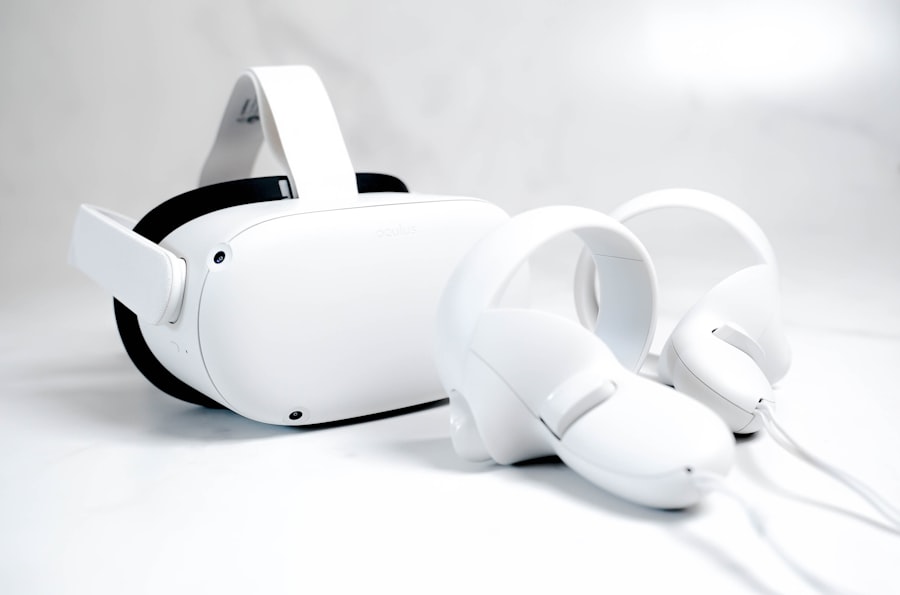Accenture’s Metaverse Continuum represents a transformative vision that integrates the physical and digital worlds, creating a seamless environment where businesses can operate, innovate, and engage with customers in unprecedented ways. This concept is not merely a technological advancement; it embodies a holistic approach to how organizations can leverage immersive experiences to enhance their operations and customer interactions. The Metaverse Continuum encompasses a range of technologies, including augmented reality (AR), virtual reality (VR), and mixed reality (MR), all designed to create interconnected experiences that transcend traditional boundaries.
At its core, the Metaverse Continuum is about reimagining the way businesses function in a digital-first world. It allows companies to create virtual spaces where employees can collaborate, customers can interact with products in immersive ways, and brands can establish a presence that resonates with their audience. This continuum is not static; it evolves as technology advances and as businesses adapt to new consumer behaviors and expectations.
By embracing this concept, organizations can position themselves at the forefront of innovation, harnessing the power of the metaverse to drive growth and enhance customer loyalty.
Key Takeaways
- Accenture’s Metaverse Continuum is a framework for understanding and navigating the evolving landscape of virtual and augmented reality technologies.
- The technology behind Accenture’s Metaverse Continuum includes virtual reality, augmented reality, mixed reality, and spatial computing, enabling immersive and interactive experiences.
- Accenture’s Metaverse Continuum is changing the business landscape by revolutionizing customer engagement, employee training, product design, and more.
- Navigating Accenture’s Metaverse Continuum requires understanding the various technologies, platforms, and applications available, as well as their potential impact on business operations.
- The impact of Accenture’s Metaverse Continuum on virtual collaboration is significant, as it enables more immersive and interactive remote work experiences.
The Technology Behind Accenture’s Metaverse Continuum
Building Blocks of the Metaverse Continuum
The Metaverse Continuum is built on a combination of cutting-edge tools and platforms that facilitate immersive experiences. At the heart of this framework are Augmented Reality (AR) and Virtual Reality (VR) technologies, which allow users to engage with digital content in a three-dimensional space.
Immersive Experiences with AR and VR
VR headsets can transport users into entirely virtual environments, enabling them to explore new product designs or participate in simulated training scenarios. On the other hand, AR overlays digital information onto the real world, enhancing everyday experiences by providing contextual data that can inform decision-making.
Enabling Technologies for a Seamless Experience
In addition to AR and VR, the Metaverse Continuum leverages advanced data analytics, artificial intelligence (AI), and blockchain technology. Data analytics plays a crucial role in understanding user behavior within the metaverse, allowing businesses to tailor experiences based on individual preferences. AI enhances these interactions by enabling personalized recommendations and automating processes that improve efficiency. Meanwhile, blockchain technology ensures secure transactions and ownership of digital assets, fostering trust in virtual environments.
Industry-Wide Applications and Opportunities
Together, these technologies create a robust ecosystem that supports diverse applications across industries, from retail to healthcare.
How Accenture’s Metaverse Continuum is Changing the Business Landscape

Accenture’s Metaverse Continuum is fundamentally altering the business landscape by introducing new paradigms for customer engagement and operational efficiency. Companies are increasingly recognizing the potential of immersive experiences to captivate audiences and differentiate themselves in competitive markets. For example, retailers are utilizing virtual showrooms where customers can browse products in a 3D space, allowing for a more engaging shopping experience that transcends traditional e-commerce limitations.
This shift not only enhances customer satisfaction but also drives sales by providing a unique platform for product exploration. Moreover, the Metaverse Continuum is fostering collaboration in ways previously thought impossible. Organizations are adopting virtual workspaces that enable teams to connect regardless of geographical barriers.
This capability has become particularly relevant in the wake of the COVID-19 pandemic, which accelerated the adoption of remote work solutions. Virtual collaboration tools within the Metaverse Continuum allow employees to interact in real-time, share ideas, and participate in brainstorming sessions as if they were physically present together. This transformation is leading to increased productivity and innovation as teams leverage diverse perspectives from around the globe.
| Metaverse Continuum Stage | Key Metrics |
|---|---|
| Physical Presence | Number of physical locations |
| Digital Twin | Percentage of physical assets digitized |
| Augmented Reality | Number of AR applications |
| Mixed Reality | Percentage of workforce using MR |
| Virtual Reality | VR training completion rate |
Navigating Accenture’s Metaverse Continuum requires an understanding of its various components and how they interconnect to create immersive experiences. Users must familiarize themselves with the different technologies involved, such as VR headsets, AR applications, and collaborative platforms. For instance, when using VR for training purposes, employees should be trained on how to operate the equipment effectively and engage with the virtual environment.
Additionally, users should be aware of the importance of user experience design within the Metaverse Continuum. The design of virtual spaces must prioritize usability and accessibility to ensure that all participants can engage meaningfully.
This involves creating intuitive interfaces that guide users through their interactions while minimizing cognitive overload. Organizations should also invest in training programs that equip employees with the skills needed to thrive in this new digital landscape. By fostering a culture of continuous learning and adaptation, businesses can empower their workforce to leverage the full potential of the Metaverse Continuum.
The Impact of Accenture’s Metaverse Continuum on Virtual Collaboration
The impact of Accenture’s Metaverse Continuum on virtual collaboration is profound, reshaping how teams communicate and work together across distances. Traditional video conferencing tools often fall short in replicating the nuances of face-to-face interactions; however, the immersive nature of the metaverse allows for richer communication experiences. Virtual meeting spaces can simulate physical environments where participants can engage in discussions, share presentations, and collaborate on projects as if they were in the same room.
Furthermore, the Metaverse Continuum facilitates asynchronous collaboration by enabling users to leave digital artifacts or notes within shared virtual spaces. This capability allows team members to contribute at their convenience while maintaining a cohesive workflow. For example, designers can leave feedback on prototypes within a virtual design studio, allowing others to review and respond without needing everyone to be present simultaneously.
This flexibility not only enhances productivity but also fosters creativity by allowing ideas to evolve organically over time.
Accenture’s Metaverse Continuum and the Future of Work

Redefined Work Environments and Improved Work-Life Balance
Employees will have greater autonomy over where and how they work, leading to improved work-life balance and job satisfaction. The metaverse provides a platform for organizations to maintain a sense of community while accommodating diverse working styles.
New Skill Sets for the Future Workforce
The future workforce will likely require new skill sets tailored to thrive in this evolving landscape. As immersive technologies become more prevalent, employees will need training in areas such as digital literacy, virtual communication etiquette, and creative problem-solving within virtual environments.
Upskilling for Success in the Metaverse Continuum
Organizations that prioritize upskilling their workforce will be better positioned to adapt to changes brought about by the Metaverse Continuum. This proactive approach will not only enhance employee engagement but also drive innovation as teams leverage their newfound capabilities to tackle complex challenges.
Security and Privacy in Accenture’s Metaverse Continuum
With the rise of Accenture’s Metaverse Continuum comes an increased focus on security and privacy concerns that organizations must address proactively. As businesses operate within immersive environments that collect vast amounts of user data, safeguarding this information becomes paramount. Companies must implement robust cybersecurity measures to protect against potential breaches that could compromise sensitive data or disrupt operations.
Additionally, privacy regulations are evolving alongside technological advancements in the metaverse. Organizations must navigate complex legal landscapes regarding data collection and user consent while ensuring compliance with regulations such as GDPR or CCPTransparency in data usage policies is essential for building trust with users who may be hesitant about sharing personal information in virtual spaces. By prioritizing security and privacy considerations from the outset, businesses can create safe environments that encourage user engagement without compromising individual rights.
The Potential Challenges and Opportunities of Accenture’s Metaverse Continuum
While Accenture’s Metaverse Continuum presents numerous opportunities for innovation and growth, it also poses challenges that organizations must navigate carefully. One significant challenge is ensuring equitable access to technology across diverse populations. As immersive experiences rely heavily on advanced hardware and internet connectivity, disparities in access could exacerbate existing inequalities in education and employment opportunities.
Organizations must consider strategies to bridge these gaps by investing in infrastructure or providing resources for underserved communities. Conversely, the opportunities presented by the Metaverse Continuum are vast and varied. Businesses can explore new revenue streams through virtual commerce or create unique brand experiences that resonate with consumers on a deeper level.
For instance, companies can host virtual events or product launches that attract global audiences without geographical limitations. Additionally, organizations can leverage data analytics within the metaverse to gain insights into consumer behavior that inform marketing strategies and product development. In conclusion, Accenture’s Metaverse Continuum represents a paradigm shift in how businesses operate within an increasingly digital world.
By embracing this innovative framework, organizations can unlock new possibilities for collaboration, customer engagement, and operational efficiency while addressing challenges related to security and access. As technology continues to evolve, so too will the opportunities presented by this dynamic landscape.
Accenture’s Metaverse Continuum is a fascinating concept that explores the potential of virtual worlds and their impact on various industries. In a related article on metaversum.it, the focus is on the collaboration between businesses and the metaverse. This article delves into how companies can leverage the metaverse to enhance their operations and engage with customers in new and innovative ways. It complements Accenture’s exploration of the metaverse continuum by providing insights into the practical applications of this emerging technology in the business world.
FAQs
What is the Accenture Metaverse Continuum?
The Accenture Metaverse Continuum is a framework developed by Accenture to help organizations understand and navigate the evolving landscape of the metaverse, which includes virtual and augmented reality, digital twins, and other immersive technologies.
What does the Accenture Metaverse Continuum framework aim to achieve?
The framework aims to help organizations identify opportunities for leveraging the metaverse to drive business value, enhance customer experiences, and improve operational efficiency.
What are the key components of the Accenture Metaverse Continuum?
The key components of the framework include immersive experiences, digital twins, extended reality, and spatial computing, all of which are essential elements of the metaverse.
How can organizations benefit from the Accenture Metaverse Continuum?
By leveraging the framework, organizations can gain insights into how to integrate immersive technologies into their operations, create new revenue streams, and enhance customer engagement through innovative experiences.
What industries can benefit from the Accenture Metaverse Continuum?
A wide range of industries, including retail, healthcare, manufacturing, and entertainment, can benefit from the framework by exploring new ways to engage with customers, optimize processes, and create innovative products and services.

Leave a Reply